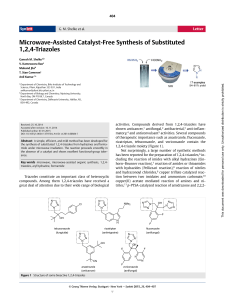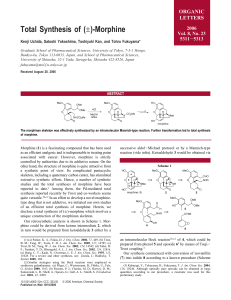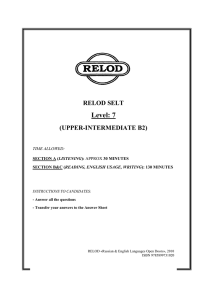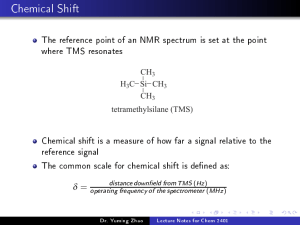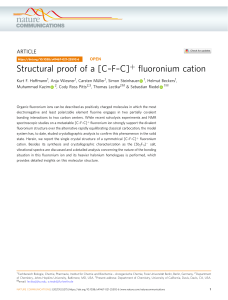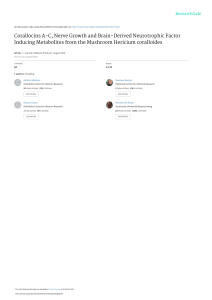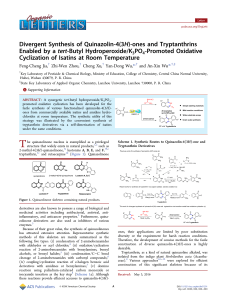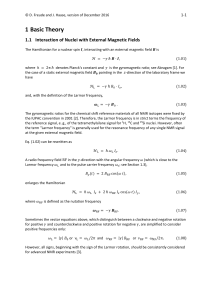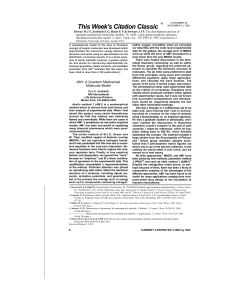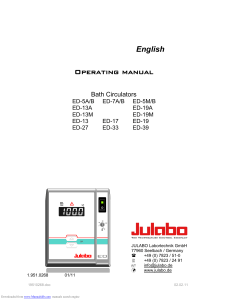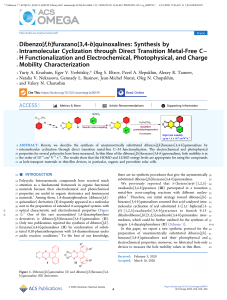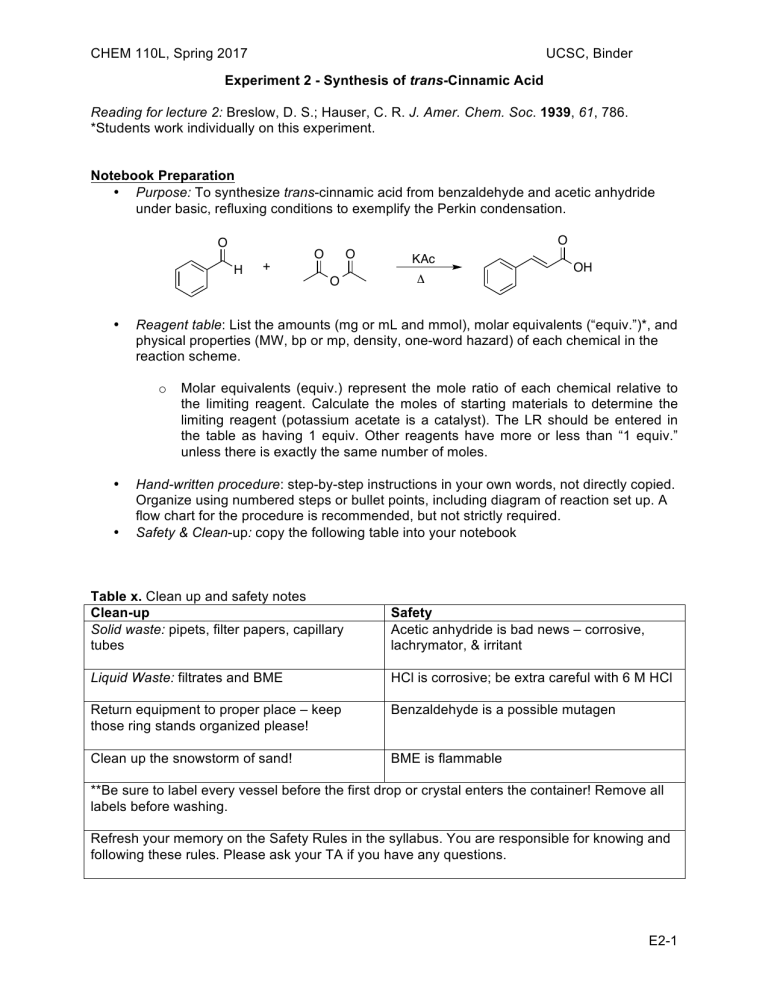
CHEM 110L, Spring 2017 UCSC, Binder Experiment 2 - Synthesis of trans-Cinnamic Acid Reading for lecture 2: Breslow, D. S.; Hauser, C. R. J. Amer. Chem. Soc. 1939, 61, 786. *Students work individually on this experiment. Notebook Preparation • Purpose: To synthesize trans-cinnamic acid from benzaldehyde and acetic anhydride under basic, refluxing conditions to exemplify the Perkin condensation. O O H • • O O KAc Δ OH Reagent table: List the amounts (mg or mL and mmol), molar equivalents (“equiv.”)*, and physical properties (MW, bp or mp, density, one-word hazard) of each chemical in the reaction scheme. o • + O Molar equivalents (equiv.) represent the mole ratio of each chemical relative to the limiting reagent. Calculate the moles of starting materials to determine the limiting reagent (potassium acetate is a catalyst). The LR should be entered in the table as having 1 equiv. Other reagents have more or less than “1 equiv.” unless there is exactly the same number of moles. Hand-written procedure: step-by-step instructions in your own words, not directly copied. Organize using numbered steps or bullet points, including diagram of reaction set up. A flow chart for the procedure is recommended, but not strictly required. Safety & Clean-up: copy the following table into your notebook Table x. Clean up and safety notes Clean-up Solid waste: pipets, filter papers, capillary tubes Safety Acetic anhydride is bad news – corrosive, lachrymator, & irritant Liquid Waste: filtrates and BME HCl is corrosive; be extra careful with 6 M HCl Return equipment to proper place – keep those ring stands organized please! Benzaldehyde is a possible mutagen Clean up the snowstorm of sand! BME is flammable **Be sure to label every vessel before the first drop or crystal enters the container! Remove all labels before washing. Refresh your memory on the Safety Rules in the syllabus. You are responsible for knowing and following these rules. Please ask your TA if you have any questions. E2-1 CHEM 110L, Spring 2017 UCSC, Binder EXPERIMENTAL PROCEDURE The two italicized sections below are the abbreviated form of the procedure (experimental methods), which is elaborated upon in the paragraphs following. “To a 15-mL RBF equipped with magnetic stir bar was added benzaldehyde (xx mmol, 1 mL), potassium acetate (xx mmol, 600 mg), and acetic anhydride (xx mmol, 1.4 mL). A waterjacketed condenser was attached and the system was heated to reflux in a sand bath (xxx °C) for 1 hour.” Heat a sand bath on a hot plate upon entering the lab. Ensure that the necessary glassware is clean and dry: 15-mL round-bottom flask (RBF), miscroscale water-jacketed condenser, and a drying tube (CaCl2, pre-made for students). Pre-heat a sand bath on a hot plate (medium setting) to 170 – 190 °C while obtaining reagents. Monitor the temperature regularly with a thermometer, but do not leave the thermometer unattended in the sand bath. Add a small magnetic stir bar then dispense the following into the RBF: 1 mL of benzaldehyde, 600 mg of potassium acetate (KAc), and 1.4 mL of acetic anhydride (fume hood only). Be careful not to cross-contaminate reagents by touching the pipet to the flask or its contents. Assemble the reflux apparatus by attaching the condenser (water hoses attached) with a Keck clip, then the drying tube. Place the RBF half way into the sand bath and clamp the condenser. Be sure the water is flowing through and filling the condenser and heat for 1 hour. In the meantime, obtain the IR of benzaldehyde and begin writing the experimental methods section of the report using the italicized headings provided. Be sure to revise these statements with the actual amounts of reagents used, including proper significant figures. “The reaction mixture was cooled, quenched with water (40 mL), made basic (pH 8-10) with saturated Na2CO3, then extracted with 2 x 10 mL BME. Crude product was precipitated from the aqueous layer with 6 M HCl (pH 2), cooled in an ice bath, then isolated as a white solid via vacuum filtration (xx mg, xx% yield).” Turn off the heat, carefully lift the apparatus from the sand bath, and let the system cool for 5 minutes. While still warm, slowly pour the contents of the flask into 40 mL of water in a 100 mL beaker. Take an initial pH measurement of the solution and add saturated Na2CO3 until the pH is 8-10. Use your best judgment in determining the proper amount and rate of addition of the basic solution. Bubbling will occur due to the formation of CO2. Use a glass stir rod to break up any precipitate that may appear. After the system has equilibrated (bubbling has subsided and system is at room temperature), transfer this aqueous solution to a separatory funnel and extract three times with 10 mL of tert-butyl methyl ether (BME). The organic extracts will be discarded at the end of the experiment. Transfer the aqueous layer (contains product as a salt) to a 250-mL Erlenmeyer flask and acidify with 6 M HCl to pH 2, being especially careful with this corrosive solution.* Cool the solution in an ice-water bath and gently scratch the walls of the flask to induce precipitation of product. Filter the solid using a Hirsch funnel. Wash the solid with cold water and dry on the filter with the vacuum on for 10-15 minutes. Weigh the crude product and calculate the percent yield to determine whether the product requires additional drying time. * Change gloves after dispensing HCl and any other time there is potential contamination. E2-2 CHEM 110L, Spring 2017 UCSC, Binder NMR Analysis: Four students will prepare NMR samples under TA supervision. Weigh approximately 10 mg of product into a dram vial and dissolve in 800 uL of CDCl3. Transfer this to an NMR tube with a clearly written label containing “Last Name, First Initial, Lab Day, Time, and TA.” Students will receive an email notification when spectra are available online. If you did not prepare a sample for NMR, you may analyze any one spectra from your section. Experimental Methods – 25 points You are strongly encouraged to write a draft of the experimental methods section, including compound characterization, before leaving lab. Use the Technical Writing Guidelines, sample experimental online, your results, and the italicized sentences in the procedure. Your TA can provide you with feedback during lab or office hours only after you’ve completed your own draft. Pre-Lab Questions – 5 points each 1. Briefly describe the role of each chemical used in the reaction: benzaldehyde, acetic anhydride, and potassium acetate. Possibilities for roles include nucleophile, electrophile, acid catalyst, or base catalyst. 2. Draw the arrow-pushing mechanism for the synthesis of trans-cinnamic acid. 3. Determine the limiting reagent (benzaldehyde or acetic anhydride) and calculate the theoretical yield. Show your work, including calculation of moles for both starting materials. 4. Briefly describe the role of water, Na2CO3, and HCl in the isolation of the product. Draw the structure of the product at basic pH (after Na2CO3 addition) and at acidic pH (after HCl addition). 5. The organic (BME) washes are discarded. What is in these organic washes? 6. What would happen if too much hot methanol were used in the recrystallization? References Palleros, D. R. Experimental Organic Chemistry; Wiley: New York, 2000; pp. 433 – 437. Perkin, W. H. J. Chem. Soc. 1868, 21, 181 – 186. Breslow, D. S.; Hauser, C. R. J. Amer. Chem. Soc. 1939, 61, 786. E2-3 CHEM 110L, Spring 2017 UCSC, Binder Post-Lab Questions – typed and turned in with lab report, 5 points each **NMR spectra and tables are posted online. 1. Report the crude and recrystallized (if performed) yields, then calculate the percent yield of the synthesis. Discuss any source of product loss (be specific). 2. Report the melting point ranges (before and after recrystallization if performed). Discuss any changes in the temperature and/or temperature range. 3. Interpret the IR spectra of benzaldehyde and trans-cinnamic acid. Include only the stretches for C=O, C=C, and O-H bonds. Use the following table format (one table per compound). IR tables for expected stretches are online. Which bands would you use to tell the two apart? Table x. IR Analysis of (Compound Name) Functional Group Bond Expected from tables (cm-1) Observed (cm-1) 4. Interpret the 1H NMR of trans-cinnamic acid using the following table format. Draw the structure of trans-cinnamic acid and label each proton. Indicate the number of H’s responsible for each signal (Integration) as well as the expected and observed splitting pattern. Estimate the expected chemical shift using the tables of expected values. You may provide a range of expected values, but calculate values if necessary to make full assignments. Students will receive an email notification when spectra are available online. If you did not prepare a sample for NMR, you may analyze any one spectrum from your section. Make a note of the label to confirm which spectrum you are reporting. Table x. 1H NMR Analysis of (Compound Name) Integration Splitting Signal (#H’s) (exp/obs) A Chemical Shift, Expected Chemical Shift, Observed 5. Interpret the 13C NMR of trans-cinnamic acid. Assign as many peaks as possible to the structure (re-draw this structure with assignments as part of your answer). You do not need to calculate expected chemical shifts, but do provide estimated values. Make a note of the label to confirm which spectrum you are reporting. Table x. 13C NMR Analysis of (Compound Name) Chemical Shift, Signal Expected Chemical Shift, observed A’ E2-4 CHEM 110L, Spring 2017 UCSC, Binder Exp 2 - Synthesis of trans-Cinnamic Acid Name _____________________________ Section Day _____ TA Name __________________________ Time _____ CHEM 110L GRADING RUBRIC - Use as cover page for report SECTION INSTRUCTOR COMMENTS IN-LAB QUIZ POINTS ASSIGNED /5 LAB REPORT ABSTRACT One paragraph, four sentences: Purpose, procedure, main result(s), and conclusion(s). NONE 0/0 INTRODUCTION Original responses to pre-lab questions with TA initials / 30 RESULTS The main results are stated, as outlined in the in-lab questions, using complete sentences. / 30 EXPERIMENTAL METHODS The experimental details (including final amount used and obtained) are briefly described in a few sentences. Compound characterization is included. / 25 NOTEBOOK PAGES Proper format: reaction scheme, chemical info table, procedure, waste and clean-up procedure. / 30 NEATNESS, ORGANIZATION, & LAB TECHNIQUE Proper order and format; proper spelling & grammar. Safety rules followed, equipment used properly. / 30 LAB REPORT TOTAL / 150 E2-5
